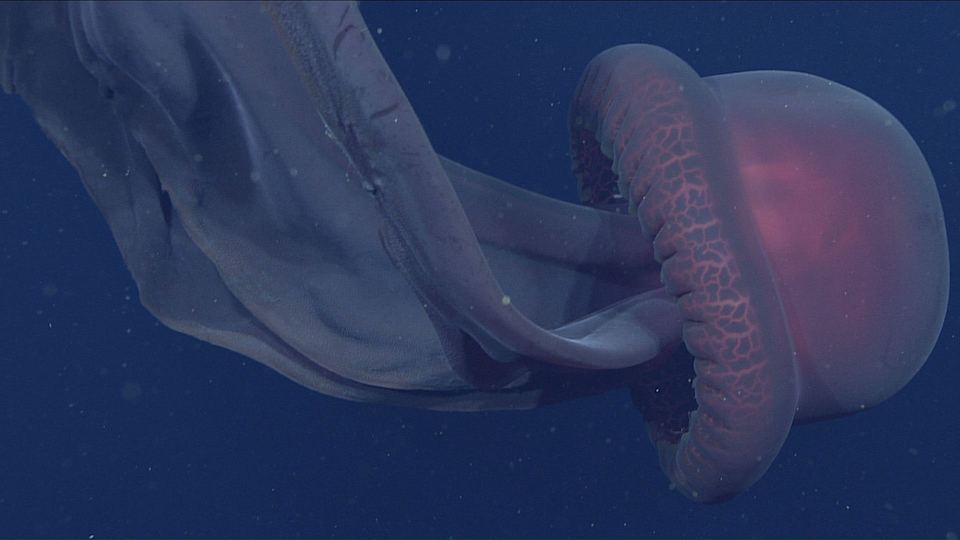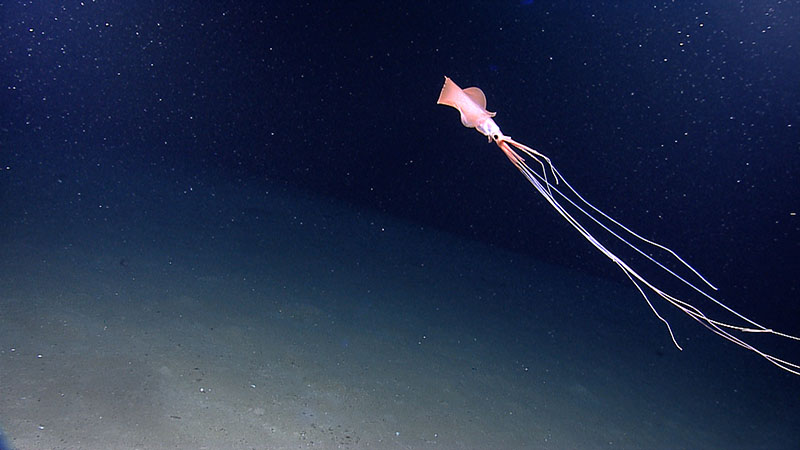
Sea creatures are one of my favorite things to look into, particularly because the ocean is so vast and deep that we hardly know anything about it. In fact, only about 5% of the ocean has even been explored. This means that there is still 95% of the ocean we know nothing about- and whether it’s due to deep sea pressure or cost, it’s difficult to increase our knowledge of the sea. For this reason, I find certain sea animals, especially ones that are hardly documented, fascinating and interesting. These are creatures you look at and wonder how you can exist on the same planet as something so… odd. Here are just a few of my favorites, and some interesting facts about them.
The Giant Phantom Jelly is, like the name suggests, a giant, ghastly-looking jellyfish that when I first saw, captivated me on a personal level. This jellyfish is beautifully colored with its deep greys and reds, and has long tentacles akin to flowing silk. Located in the Midnight Zone (depths from 3,300-13,100 feet where the only light comes from bioluminescence of animals themselves), this jelly is a rare sight. Its depth is actually around 21,900 feet deep, and it’s around 3.3 feet across and 33 feet long- truly a giant jellyfish, and really far away from the surface.
This jelly lives all across the world except for the Artic Ocean, and is presumed to eat plankton and small fishes. Despite this, the Phantom Jelly has only been spotted nine times on MBARI (Monterey Bay Aquarium Research Institute) ROV (remotely operated vehicle) dives. While the first specimen was collected in 1899, this jellyfish would not be known as a new species for another 60 years!

Ecologically, the Giant Phantom Jelly acts as a host to smaller fish, allowing them safety in depths where cover is hardly an option. These fish use the “bell” of the jelly to conceal themselves, as well as the jelly’s long tentacles. This is a common occurrence between gelatinous creatures such as jellies and fish in environments such as the Midnight Zone.
Before you ask- yes, this is a real animal that exists- and yes, it’s surprisingly adorable. This squid is part of a family of marine animals called cephalopods (which also include octopi and nautili), and was aptly named for it’s huge, comical eyes akin to googly eyes for arts and crafts. The stubby squid’s coloration ranges within red-brown and grey-green, and it is able to change color to match its environment. You can find this squid in colder waters living in sandy or muddy habitats around depths of 60-4,260 feet deep, but you’re most likely to find it around 3,000 feet deep. The squid was recently found in 2016 after researchers on the E/V Nautilus stumbled upon the silly looking creature during a recorded dive.

The Stubby Squid lives in the Northern Pacific Ocean and can be found in the waters between Southern California and Japan, though its broad range allows it to be found in most of America’s west coast sanctuaries such as Olympic Coast, Greater Farallones, Monterey Bay, Cordell Bank, and Channel Islands. A nocturnal hunter, it eats using a hardened beak near the center of its body and has a diet composed of mostly shrimp, but will also eat crabs, mollusks, small fish, and other cephalopods.
The Stubby Squid can actually survive in even the most polluted areas due to its short lifespan and protective mucus layer, but habitat destruction resulting in lack of food sources threatens to leave it vulnerable to population loss.
The last and most mysterious sea creature is the Bigfin Squid , a family we still hardly know anything about despite initial species discovery around 20 years ago. Not unlike the Phantom Jelly, the Bigfin Squid has only been captured 10 times worldwide, making it another rare sight for deep sea divers. The Bigfin Squid can live deeper than any other squid at depths around 7,825 feet to 15,535 feet (not as deep as the Phantom Jelly, but still very deep!) and is characterized by it’s large fins and eight long arms that bend in a strange, elbow-like manner. The squid can average around 19.7 feet in length, but the largest known Bigfin Squid was 21 feet long, with it’s tentacles making up 20 feet of that length- talk about long, long, long tentacles!
Since not much is known about the Bigfin Squid, scientists can only speculate on how it uses its large tentacles. Right now, the current theory is that by using the microscopic suckers on its tentacles, the squid uses them to trap unfortunate prey unlucky enough to bump into its grasp as its long tentacles hang in water or drag along the sea floor.

